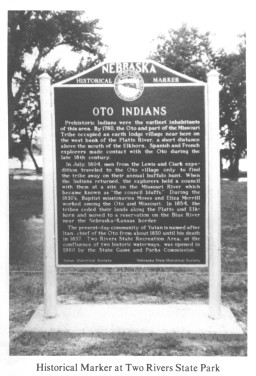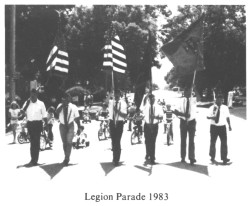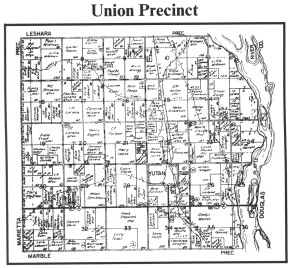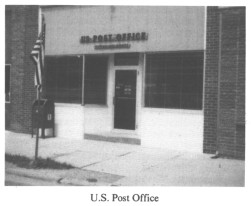|
good gathering places for people as they picked up their mail. It was an opportunity to exchange remarks about the crops, the weather, some special incident in the community, or some political information. Of course this has been true of Yutan also. The people in the older section of town still get their mail at the postoffice. But in the two housing developments, one east and one south of town, the people receive their mail from a rural postal carrier. The Post Office in Yutan serves about 2,000 people. Submitted by Donis Hancock and JoAnn Schulz
 |
| Historical Marker at Two Rivers State Park |
THE OTO AND MISSOURI
INDIANS AT YUTAN
The Oto and Missouri Indians who were members of the Sioux family migrated west in the early 1600's from the Ohio Valley. French maps show that they were living in southern Minnesota and northern Iowa in the early part of the 17th Century. About 1680 they traveled south and settled along the Grand River in Missouri. In the early 1700's the Oto moved into Nebraska settling on the Nemaha River. Records show that they had villages near Omaha, Fremont and Ashland between 1715 and 1775.
The Missouri, whose tribe had been decimated by a smallpox epidemic and also by raids from more warlike tribes joined the Otoes at their Fremont village on the south side of the Platte about 1768. Raiding bands of Pawnees compelled them to move again, this time on Clear Creek about l ½ miles southeast of the present site of the town of Yutan. Here they remained for about 60 years, -- until 1835.
While at this location on Clear Creek the Oto and Missouri adopted a more settled form of life. They built earthen lodges 40 to 60 feet in diameter, making a structure of cottonwood logs covered with willow branches and sod. The lodges opened to the east with a long passageway providing protection from the elements. Each family had a garden where they grew beans, corn, pumpkin, and squash.
Twice a year the able bodied men of the tribe went to the western part of the state for the buffalo hunt. For this they carried the portable tepee made of buffalo hide. The summer hunt lasted 2 to 3 months, and the winter hunt usually lasted from mid-October to mid-December.
The Oto and Missouri were religious. They believed in one God, whom they called WaKonda. Prayers of thankfulness and prayers for guidance were very much a part of their daily lives. They also felt a strong affinity for the earth which they referred to as "Mother Earth." They believed in life after death and carefully prepared the bodies of their deceased for the journey into the hereafter.
Within the Indian tribes each clan had a leader, and from these leaders a head chief was selected as ruler. The most famous chief of the Otoes was Itan, born about 1785. His given name was "Shon-mon-i-case" which meant "Prairie Wolf." The title "Itan" or "Ietan" was given to him because of his success in battle against the Ietan Indians, an Apache tribe.
The Oto and Missouri pledged their allegiance to the United States in 1804 when they met with Lewis and Clark. Later, in 1821, Shonmonicase and his wife went to Washington, D.C., with a delegation of Indians to meet President Thomas Jefferson. Chief Shonmonicase (later known as Chief Itan) was a very handsome man and his wife was considered beautiful; they were well received in the nation's capitol.
Chief Itan died in 1837 at the Baptist Mission near Bellevue where the entire Oto-Missouri tribe had moved in 1835. He was 50 years of age. He got into a fight with two young braves who had run off with one of his wives and he was killed in the fight, as were also the two young Oto men.
The Oto-Missouri never regained the strength and solidarity which they enjoyed under Chief Itan but they did retain pride in their traditions and customs. They had moved to Oklahoma in the 1850's because they felt confined with life on reservations in Nebraska. But some of them try to return to Nebraska during the summer months to take part in the powwows at Macy, Omaha, Lincoln, and Winnebago. The Indians have left a lasting heritage in the Midwest and especially in Nebraska.
YUTAN WOMEN'S SERVICE
ORGANIZATION
In October of 1971 the Yutan Mrs. Jaycees were founded and organized with the help of the Millard Mrs. Jaycees. The very first officers were President; Joyce Badders, 1st Vice-President; Terry Nolting, 2nd Vice-President; JoAnne Shively, Secretary; Pat Wallace, and Treasurer; Sharon Ogden.
They turned over their charter in January of 1977 and became the Yutan Women's Service Organization (Y.W.S.O.) The group currently has thirteen members and still serves the same purpose that they did when they began, which was to sponsor and serve the community for both profit and fun. The presiding officers for the 1983 year are President; Kathy Renter, Vice-President; Jan Dibble, Treasurer; Debbie Robinson, and Secretary; Mary Hansen. Kathy Renter, President Y.W.S.O.
YUTAN AMERICAN LEGION
POST #262
The charter for the Yutan American Legion Post #262 was signed July 7, 1952. There were 34 Charter Members. Some had been members of other Legion Posts before #262 was organized.
Charter Members were: Kenneth Anderson, Arley A. Beach, Homer J. Bohlen, Gordon Dau, Laurence Draper, Claus Drews, Wayne D. Drews, Roland Beach, LeRoy Eggers, Harvey H. Eggers, Hans Hollst, Howard A. Jacobs, William W. Jensen, Delwin E. Johnson, David Kennec, Verner Kirchmann, Dale W. Kuhr, Lauren L. Kuehl, Lowell F. Loeffler, Irving H. Lorenz, Richard D. Miners, Ernest G. Mumm, Herman Mumm, John Nielsen, Hubert H. Peters, Elias P. Pilfold, Henry C. Schleu, Harry J. Schulz, Charles Sievers, Elmer Sievers, Irving H. Stange, Claus H. Stange, Harry W. Trost and Melvin D. Turner.
The Post is very proud of Charter Member Hans Hollst, who is 87 years old and still an active member.
The Legion Post has contributed to and promoted many worthwhile community projects, one being sponsor of the baseball teams for many years.
The 1983 membership of the Post stands at 80 Legionaires. Our current project is the building of a Memorial at the Hollst Lawn Cemetery south of Yutan. On each Memorial Day Legion members meet to honor the Veterans who have died. They place flags on the graves of the four cemeteries in the Yutan area, and provide a Memorial Service for the Community.
Legion Members associate themselves together to uphold and defend the Constitution of the United States of America, and to foster and perpetuate one hundred per cent Americanism. The present Commander of the Yutan Legion Post is Lyle Kuhr.
 |
| Legion Parade 1983 |
YUTAN AMERICAN LEGION
AUXILIARY UNIT #262
The Yutan American Legion Auxiliary Unit #262 was organized in 1956 with 24 charter members. The Unit assists the Legion in its aims and programs.
The charter members were: Lorraine Anderson, Janet Behrens, Marianne Bull, Lucille Christiansen, Elsie Drews, Carol Ecklund, Lois Heldt, Emma Kennec, Betty Kirchmann, Gertrude Kuehl, Evelyn Lorenz, Anne Mumm, Neva Peters, Marian Stamp, Jean Stange, Rickie Stange, Rose Stange, Faye Stranathan, Gladys Storm, Marian Trost, Evelyn Turner, Eileen Wagemann, Viola Wendt, and Donna Yocum.
The present membership stands at 31 members. Doris Karloff is the current President.
To advance the cause of Americanism, the Auxiliary sponsors a girl to Girl State each year. For God and Country we associate ourselves together to safeguard and transmit to posterity the principles of Justice, Freedom, and Democracy.
YUTAN VOLUNTEER FIRE
DEPARTMENT
Yutan village records show that the town purchased fire extinguishers from Ferrill & Company of Omaha in 1895 for $90. On November 3, 1903, "Truck Number Three" with hooks, ladders, and buckets was ordered from Lindgren-Mahan Company in Chicago for $225.40 plus $68 in freight.
There was no organized fire department. When the fire bell rang it was the duty of every able-bodied man to turn out to fight fires. This was done by bucket brigade, -- water being relayed by buckets, man to man, from nearby wells, watering tanks, or cisterns, and tossed on the fire. This method was used until 1910 when a water system was installed with mains, hydrants, and a tower.
On May 31, 1921, a group of 19 men met at Cowles Drugstore to organize the Yutan Volunteer Fire Company. Hubert H. Peters was elected President, H.D. Rohde Vice-President, Harry P. Sievers Chief, and A.C. Jensen Secretary-Treasurer. During 1921 the Company answered two alarms, -- one at the Morton Hotel and one at the Lyric Theatre.
After a fireman was injured fighting a fire and the Village Board refused to pay the $4 doctor bill and $2 for trousers, the men decided to re-organize under State Law and to be tax-supported by the Village. A new constitution and bylaws were adopted and new officers selected. Fred O. Zaugg was elected President, Hubert Peters elected Secretary-Treasurer, and Harry Sievers was continued as Chief.
In June, 1922, twelve rubber coats were bought
page 145
|




